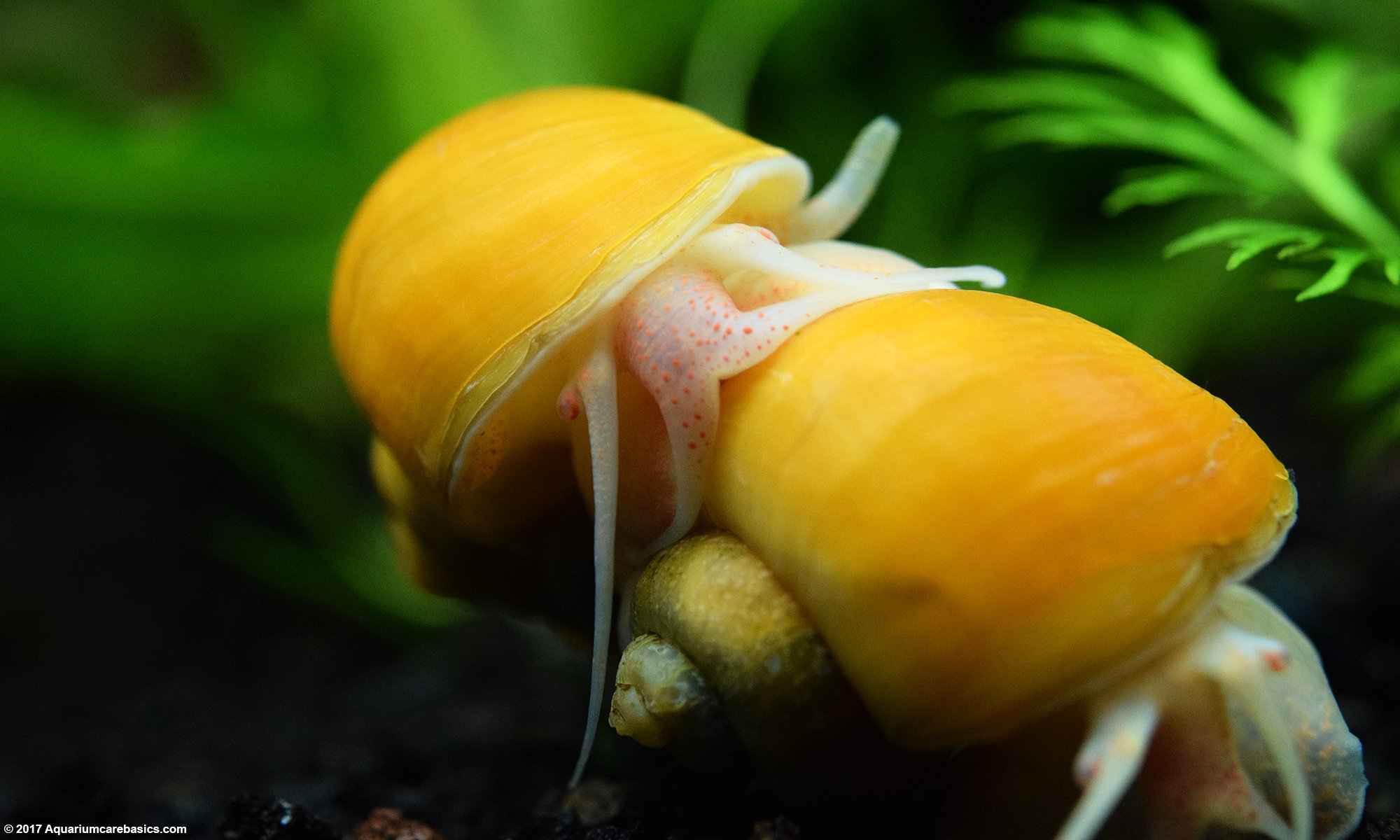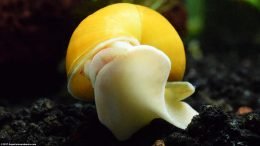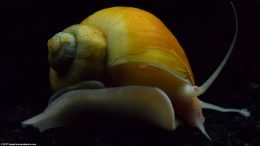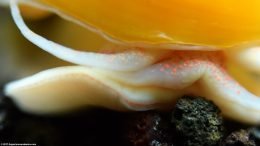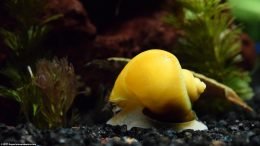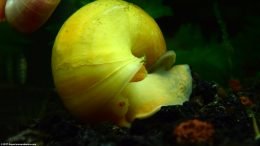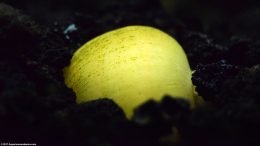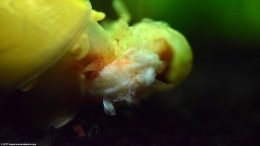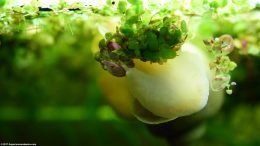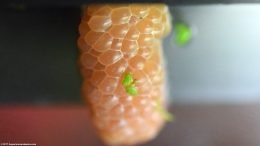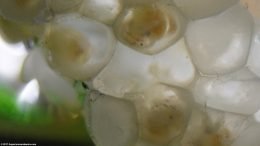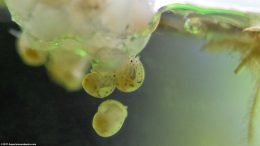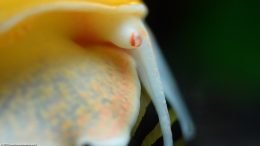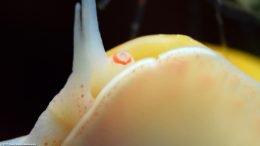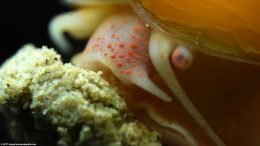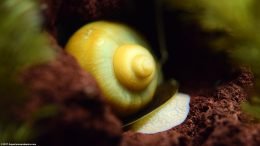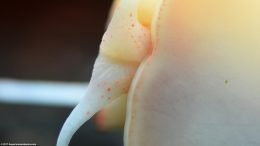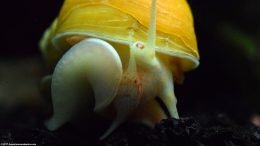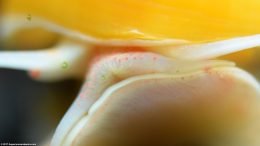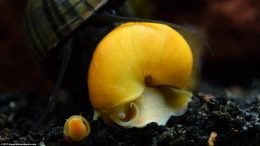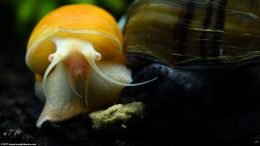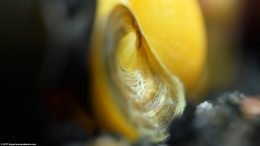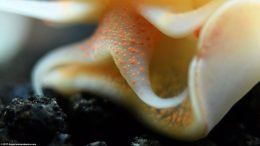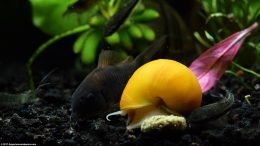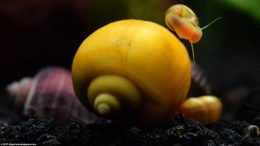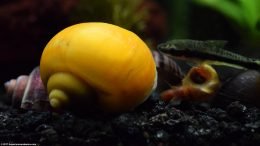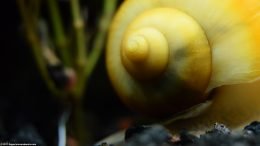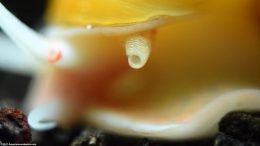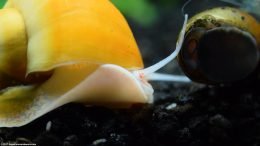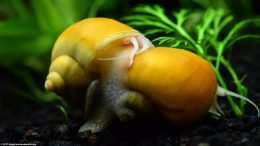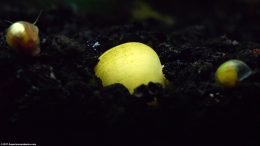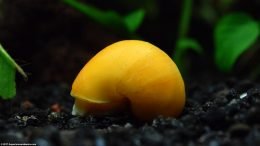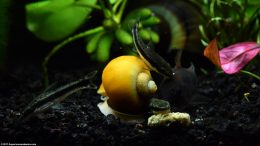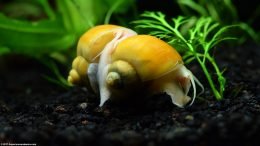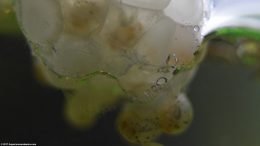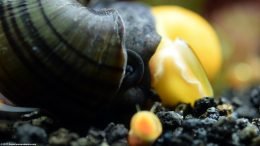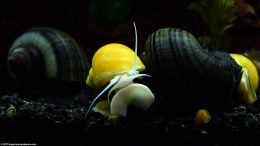The Gold Inca Snail is a freshwater aquarium snail often found in pet stores these days. A Gold Inca Snail color is deep yellow and gold with a creamy white body, head and foot. A Gold Inca Snail has several orange dots sprinkled across it head just above and around its mouth. Orange dashes appear on its siphon and orange rings appear around its eyes. Its creamy white and orange color combination, combined with its yellow-gold shell, can really stand out in an aquarium. Especially in tanks with rich green plants, a black substrate and a black background.
When Buying a Gold Inca Snail
There may be inconsistencies with names from store to store. These snails can also be sold as a Gold Mystery Snail, a Golden Mystery Snail, a Golden Inca Snail, a Golden Snail, a Yellow Snail, an Inca Snail or by some other name. And as with all aquarium purchases, avoid buying Inca Snails from a tank with dead or dying inhabitants. Tanks such as these may indicate poor conditions or diseases, and its better to avoid all of that as opposed to getting involved with it.
When buying a Gold Inca Snail, look for snails with non-cracked, thick non-pitted dark yellow or gold color shells. Shells that are thin, cracked or pitted can be indications that the snail is unhealthy or has been in water that is acidic and low in calcium. Also make sure the Gold Inca Snail is stuck on the glass or moving across hard surfaces. If a Gold Inca Snail is laying motionless on the bottom of the tank, lying upside down or floating on the surface of the water, it may indicate that the Gold Inca Snail is dead or dying. Finally, keep in mind that a Gold Inca Snail be kept in the store with tank mates that may take nips at their eyes and tentacles, so make sure the snail’s eyes and tentacles are intact.
Gold Inca Snail Images
Gold Inca Snail Temperament & Behavior
A Gold Inca Snail is peaceful by nature preferring a calm environment with non-aggressive tank mates. Gold Inca Snails have no means to attack other aquarium inhabitants and can only use its shell and operculum to defend itself. A Gold Inca Snail can be very active during times when the tanks lights are on, steadily travelling throughout the aquarium on the hunt for food, interesting places to explore, or a quiet place to take a break. A Gold Inca Snail can also be very active when the tank lights are off. Inca Snails are often busy feeding at night in complete darkness.
Gold Inca Snail Care
The good news is that Gold Inca Snail care is pretty simple, making the snail good for beginners. One thing that snail keepers should do is periodicity take a “shell count” to make sure all the snails are in the tank. An Inca Snail may try to get out of the tank, so its important to keep the tank well covered. An escaped Gold Inca Snail can die from drying out.
Another Gold Inca Snail care issue often overlooked is how the snail is added to a tank. An upside-down Gold Inca Snail may have a hard time turning over when coming out of its shell. A Gold Inca Snail will open its operculum and extend its foot reaching for a hard surface like gravel or substrate. If the Inca Snail’s foot cannot reach a hard surface, the snail may be unable to turn over and right itself. And if too much time passes, the snail could die.
Tank Hazards
Another Gold Inca Snail care issue is the hazard of a strong filter intake. A Gold Inca Snail may be drawn to an intake to explore and feed. The danger for the snail is that it may get its head stuck in the intake. Between the water current and the snail swelling up, it may be unable to pull itself out and it could very easily die. Trying to rescue a trapped Inca Snail may be even more harmful. A beginning hobbyist may be tempted to pull the snail from the water intake and kill it by accident. The better practice is to try to avoid the problem altogether by placing sponge pre-filters over strong water intakes in advance of trouble.
Gold Inca Snail Size
At the store, Gold Inca Snail size may be about an inch or so when purchased. Some snails can be a smaller, but most will be about a the size of a quarter.
Tank Size & Water Considerations
When adding a Gold Ina Snail to an aquarium, tank size, water conditions and the tank’s limitations are some of the first things to consider. Hobbyists often add a bunch of snails to a tank as an “aquarium cleaning crew”. But snails tax the bio-load of the tank like other living organisms. Keep in mind that a Gold Inca Snail is just like any other tank inhabitant. Snails feed from their aquatic world and they produce waste into it. A Gold Inca Snail needs to be in an established tank with sufficient size and water volume to support their life.
In terms of actual aquarium size, like many other snails a Gold Inca Snail can thrive in small established tanks, like 5 or 10 gallon aquariums, or in larger established tanks as well. Whichever is chosen, make sure the basic rules against overstocking followed. The tank should be established and stable. Ammonia and Nitrite levels should be at 0 ppm. Along these lines, Nitrate levels need to be kept in check with regular partial water changes. And be wary of tank medications, treatments and plant fertilizers as they can be harmful or fatal to an Inca Snail. The same goes for additives containing copper.
Calcium Is Important
A Gold Inca Snail should be kept in aquarium water on the hard side, with sufficient calcium levels to maintain healthy shell growth. The shell whorl should be smooth-ish in texture from the apex to just above the mantel. The shell should not be thin or have excessive cracks or pits. Thin, cracked or pitted shells can indicate a calcium deficiency, so periodic calcium supplements may be necessary.
A Gold Inca Snail can do well in a wide range of aquarium water conditions. Staying within the tropical community fish tank range is a good start. My preference is for moderately moving, clear, oxygen rich water. Some hobbyist suggest that a Gold Inca Snail can do well in still water on the murky side. That may work too, but for aesthetic purposes, my personal preference is clear tank water.
Aquarium pH: 7.2 – 7.5, with some suggesting lower pH acceptable.
Water Temperature: 68 – 82 Degrees Fahrenheit.
Hardness & Minerals: On the hard side, with calcium supplements.
Lighting: Normal community fish tank lighting.
Gold Inca Snail Environment & Habitat
My Gold Inca Snail population seem happy and do well in a planted aquarium. I suspect the reason is that a tank with lots of live plants is never really too clean, meaning that there is a plentiful source of edible vegetation shedding from the live plants themselves (see note regarding live plants below). And if a Gold Mystery Snail takes a couple bites off a live aquarium plant once in a while, I chalk it up as its having some fresh vegetation as a snack.
Gold Inca Snail Diet: Food & Feeding
A Gold Inca Snail makes a good tank cleaner. As a scavenger, an Inca Snail can be a ferocious eater when feeding. Adept at scouring hard surfaces for edible material, a Gold Inca Snail seems to enjoy eating soft algae growing on aquarium glass, decorations, rocks and other hard surfaces like slow growing plant leaves. Inca Snails don’t seem to be interested in Green Spot Algae growing on glass, as it is probably too hard for them to ingest.
In addition to edible matter that grows naturally, a Gold Inca Snail should be fed supplements of fish food, bottom feeder pellets and algae wafers. Its not a good idea to think that snails can survive solely on naturally growing matter as the snail may starve. In addition to store bought food, a Gold Mystery Snail may also like supplements of washed soft blanched vegetables such as leaf lettuce, iceberg lettuce or green zucchini squash. Experiment with different vegetables to see what the snail is interested in. Generally, if a snail is not interested in the vegetable after one day, I take it out. Leaving uneaten vegetables in the tank too long is not good for water quality. The same goes for overfeeding with fish food and pellets.
Live Aquarium Plants
Regarding live aquarium plants: Some hobbyists say that a Gold Inca Snail can devour planted tanks. This may be true in some instances. But whether a Gold Inca Snail devours live aquarium plants may also have something to do with the type of plants kept, how hungry the snail is, and the snail itself. Keeping Inca Snails live plants with durable leaves like Anubias Barteri and Amazon Swords should not be a problem. That said, some Gold Inca Snails seem to enjoy eating floating Salvinia plants, for example. Keeping some Salvinia floating in a tank may help satisfy the snail’s plant cravings and at the same time divert the snail from eating other plants. Different hobbyists may have different experiences with snails and live plants, so the issue is worth a mention.
Gold Inca Snail Lifespan & Dead Snails
A Gold Inca Snail lifespan is about one year, or maybe more if conditions are good and the snail is lucky. That said, its not uncommon for a Gold Inca Snail to die shortly after being added to a tank. Death may be attributable to the stress of being transported from the store. The shift in water parameters between store tank water and the water in the new environment can be an issue as well.
Identifying a dead Gold Inca Snail not difficult. Observe the snail’s behavior. If the Gold Inca Snail is motionless on the bottom of the tank, is upside down, swollen, or floating in the water for longer than usual, remove the snail with a fish net. A dead snail gives off a strong, repugnant rotting odor. When a strong smell is present, the snail is dead and should not be returned to the tank. If the odor is not present, place the snail back in the tank right-side up. If the snail remains in that position for longer than usual, check again for the strong odor. The snail may be deceased. A dead Gold Inca Snail should be removed from a tank as soon as possible to avoid Ammonia spikes or other water problems.
Gold Inca Snail Tank Mates: Peaceful
Gold Inca Snail tank mates can be non-aggressive freshwater community tank fish with shy, peaceful temperaments. Tank mates can include freshwater shrimp like: Amano Shrimp, Ghost Shrimp, Red Cherry Shrimp, Bamboo Shrimp and Vampire Shrimp. Other freshwater snails like Nerite Snails, Ramshorn Snails, Ivory Snails, Trumpet Snails and Mystery Snails are a good match too. Regular calm community tank fish are good choices as are bottom feeders and algae eaters such as Cory Catfish and Otocinclus Catfish.
Goldfish and tough roughens like Jack Dempsey, Striped Convicts, Oscars and other cichlids should be avoided. They may eat a Gold Mystery Snail. Tough customers can pick at the snail, yanking off its eyes, tentacles or both. Or worse, they can eat the Inca Snail outright.
As always, if there are any questions about tank mates and compatibility, check with the clerk at the store to get his or her input. They should know whether a species will make good tank mates for a Gold Inca Snail.

